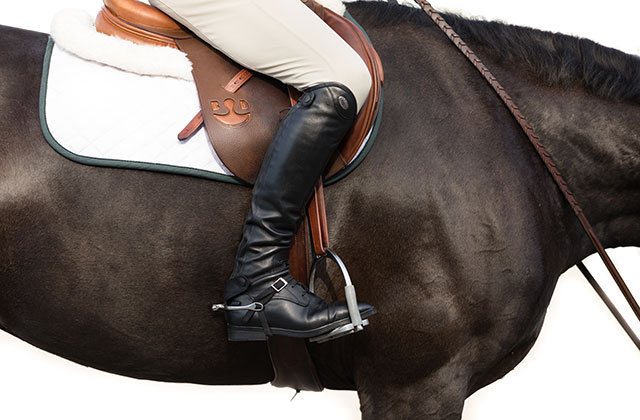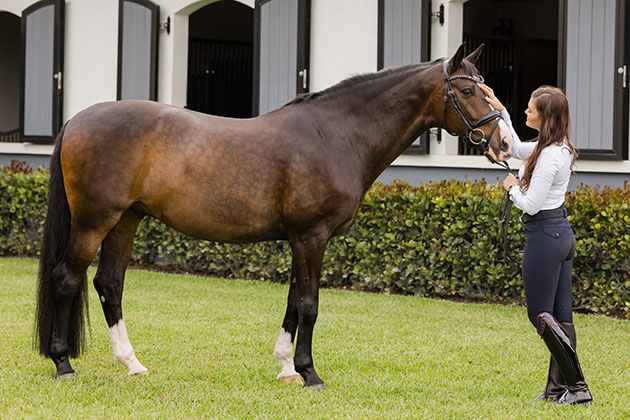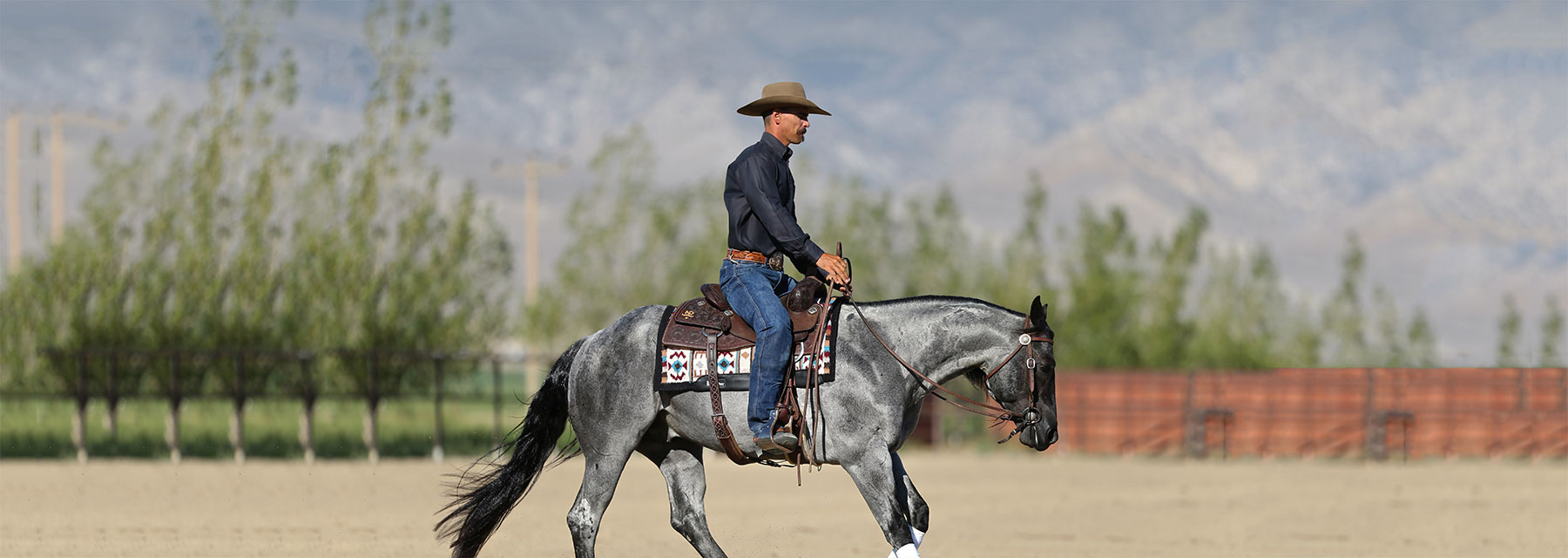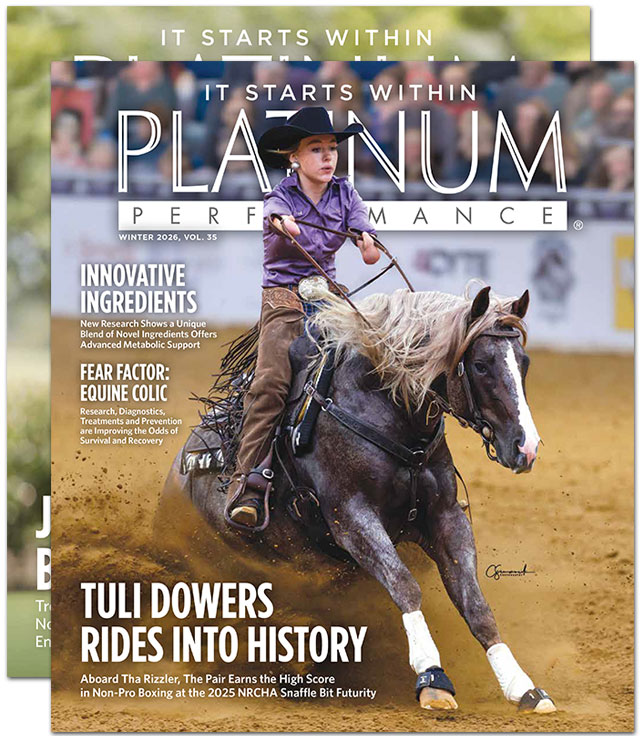Give Your Horse a Variety of Nutrients for a High-Gloss Coat
There is no better testimonial to a horse’s overall wellness than a healthy, shiny coat. That shine stems from the inside out and is reliant on what the horse eats. The skin of the horse is a reflection of the nutritional status of the body as a whole as hair coat (and hooves) are lower on the list of the body’s nutrient triage compared to vital organs necessary for survival, such as the brain and heart, and the musculoskeletal and nervous system requirements. Nutrients that remain available after satisfying more critical needs will then be used to fulfill those of the skin, hair and hooves. Basically, if there is a fundamental deficiency in the horse’s diet, the coat and hooves will often be the first to show the problem as quality will decline. Dry, flaking skin, general coat dullness, bleaching, a scruffy or thin coat or slowed rate of growth can all be issues stemming from a horse’s lack of nutritional soundness.
The most important dietary component to support skin and coat condition is to ensure each horse is being fed a well-balanced diet that meets the specific needs for the individual’s stage of life and workload. There are several nutritionally related factors that influence the health of the horse’s skin and coat, although it is very important to rule out other possible causes with a veterinarian that would include intestinal parasites, poor dental occlusion, gastric ulcers or chronic illness. Nearly all skin and coat problems respond exceedingly well to a comprehensive diet that includes high-quality protein with an adequate amino acid level, balanced minerals, vitamins and omega-3 fatty acids.

Protein: Quantity & Quality
Hair is over 90% protein. Keratin, a specialized protein, provides the structural support and outer protective layer for hair. Although a dull coat or poor hair growth can be an indicator of protein deficiency, this is not very common in the modern equine diet. Many people assume that general protein quantity may be an issue, but again this typically is not the case unless the horse is fed a truly low-quality hay-only diet (with crude protein less than 8%) and fed less than 2% of their body weight daily. The issue is more likely not a lack of general protein in the diet, but a shortage of key amino acids, particularly lysine and methionine. Lysine and methionine are needed to produce all proteins in the body, including keratin. Lysine is important because it is typically the one that is in the least amount in the diet, and all amino acids must be present in order for the body to make protein. Methionine is a sulfur containing amino acid critical for skin and connective tissue health. Sulfur-containing amino acids are important for hair production. It is provided easily by high-quality protein sources. A simple and natural way to improve the amino acid profile of a diet is to offer a variety of hay types. Adding a legume, such as alfalfa, offers an excellent amino acid profile and complements many other forages. Using a high-quality, comprehensive supplement with a full amino acid profile can also boost levels of amino acids available in the diet.
Vitamins & Minerals
Vitamin A, or its precursor beta carotene, is important for maintaining healthy skin Although not commonly deficient in the equine diet, vitamin A may need to be supplemented if a horse does not have access to pasture and is fed poor quality grass hay that is older than 6 months. The B vitamin complex plays a critical role in just about everything biologically, and skin, coat and hoof health is no exception. Two notable B vitamins necessary for skin health are biotin and pyridoxine (B6). Biotin is required for the health of all skin and connective tissues. Pyridoxine is needed for the normal metabolism of protein. A deficiency in B vitamins, typically biotin, is sometimes seen in older horses and can result in balding or thinning hair or as extremely dry skin or scaling. Vitamin E, a powerful antioxidant, can be deficient in horses without access to green grass and not fed a feed fortified with vitamin E. Inadequate amounts of vitamin E in the diet can be a contributing factor to dry skin, skin infections and allergic reactions. The natural form of vitamin E, d-alpha-tocopheryl acetate, is bioavailable and often supplemented to horses without access to pasture.
Every mineral is important for the whole body functioning in the horse. Copper, silicon and zinc are all trace minerals that play a pivotal role to the health of the skin and coat, and are commonly deficient in the equine diet. Deficiencies can be seen as brittle hair, dull coat and discoloration of coat hair or manes and tails. The skin can be less resistant to infections and may be more prone to an exaggerated inflammatory response. Zinc is critical to skin health and deficiencies of zinc can manifest as dry skin, dull coat and lowered resistance to infections. Copper is needed for the normal production of skin and coat pigments. The balance of zinc and copper is important to be aware of as high levels of copper may interfere with the absorption of zinc and should be kept in a ratio of 3-4:1 zinc to copper.

96% of Clients Report a Positive Effect on Their Horses’ Hair Coats Using Platinum.
Fats & Oils
Although the natural diet of the horse is relatively low in fat, about 2-3% of the total diet, a true lack of fat can be correlated to dry, brittle hair coats. The addition of dietary fat, such as an oil or fatty acid supplement, can increase the amount of oil secreted by the skin’s sebaceous glands. This helps to add oiliness and sheen beneficial for dull hair coats. Dietary fats are also needed to process the fat-soluble vitamins: vitamins A, D, E and K. Essential fatty acids are necessary for skin and coat health. The horse relies on consuming essential fats through the diet as they are unable to be created within the body. While all fatty acids are important, the ratio of these fatty acids are is very influential on wellness. The natural grazing diet of the horse provides up to 5 times more omega-3 fatty acids than omega-6 fatty acids. Omega-3 fatty acids are constituents of every cell membrane in the entire body. They improve cell membrane integrity and function and are precursors to weak or non-inflammatory mediators. In a typical modern equine diet with the inclusion of grains and reduced availability to pasture grazing, horses are getting much higher levels of omega-6 fatty acids and not enough omega-3 fatty acids, estimated up to 18 times more omega-6 than omega-3 fats. Omega-6 essential fatty acids are precursors for potent inflammatory hormones. An imbalance of these critical fatty acids can insult the immune system and allergic response and can cause an inflamed state in the horse, making them prone to allergies and other inflammatory diseases. A deficiency of omega-3 fats can lead to overly sensitive, itchy and inflamed skin as pro-inflammatory mediators have taken the place in an animal that naturally thrives on a natural anti-inflammatory diet. Shifting the ratio of essential fats more to what a horse would normally be getting in the wild, inflammatory reactions are decreased systemically in the intestines, joints, respiratory tract, and certainly in the skin. Using the diet to boost omega-3 content with flax, algae and other sources supports the immune system and a beautiful, healthy hair coat is the result of internal balance.
Top-dressing oil on various feeds is a common feed room supplement for shiny coats, however, not all oils are created equal. Corn oil may support shine, but it comes with a price on health. Corn oil, as well as many other vegetable oils and grains, contain high levels of omega-6 essential fatty acids. Giving corn oil on a daily basis can cause chronic inflammation linked to a wide variety of diseases. A healthy alternative for a beautiful coat is cold-pressed flaxseed oil, an excellent source of anti-inflammatory omega-3 essential fatty acids.
In Conclusion
The quality of the horse’s skin and coat is a good indicator of the horse’s general health and the adequacy of his diet. Daily grooming and currying are excellent ways to improve circulation, remove loose hair and promote shine. A little baby oil, coat conditioners and sprays may help for a temporary shine. But there is no replacement for the beautiful, shiny bloom that comes when a horse is receiving a variety of nutrients to produce a naturally sleek, high-gloss coat.
Poor hair coat quality, as well as hoof quality, are often the first indicators of dietary imbalances, whether stemming from excesses or deficiencies. Analyzing pasture, hay and feeds is one way to know that what is being fed is sufficient, but it can also be difficult, time-consuming and hard to interpret. Comprehensive supplements that provide amino acids, vitamins, minerals and omega-3 fatty acids are a simple way to ensure that a horse is consuming the building blocks necessary for a healthy coat. A balanced diet provides nourishment for each hard-working cell in the horse’s body. When the cells are fed optimally, they function optimally. And when a horse feels good, he looks good. Chances are that when you see a well-conditioned horse gleaming in the sun that his nutritional needs are being met. And there are few things easier to appreciate than seeing health, personified.

Platinum Protocols for Skin
& Coat Health
Shiny Hair Coat: Administer 1 scoop of Platinum Performance® Equine* twice daily.
Dry, Scaly or Brittle Skin & Coat: Administer 1 scoop of Platinum Performance® Equine* and 1/8 cup of Healthy Weight twice daily.
Vitiligo/Skin Depigmentation: Administer 1 scoop of Platinum Performance® Equine* twice daily and 1 scoop of Platinum Hoof Support once daily.
* Platinum Performance® Equine, Platinum Performance® GI, Platinum Performance® DJ or Platinum Performance® CJ are each appropriate foundation formulas for this protocol.

by Emily Smith, MS,
Platinum Performance®

